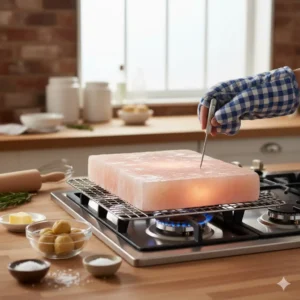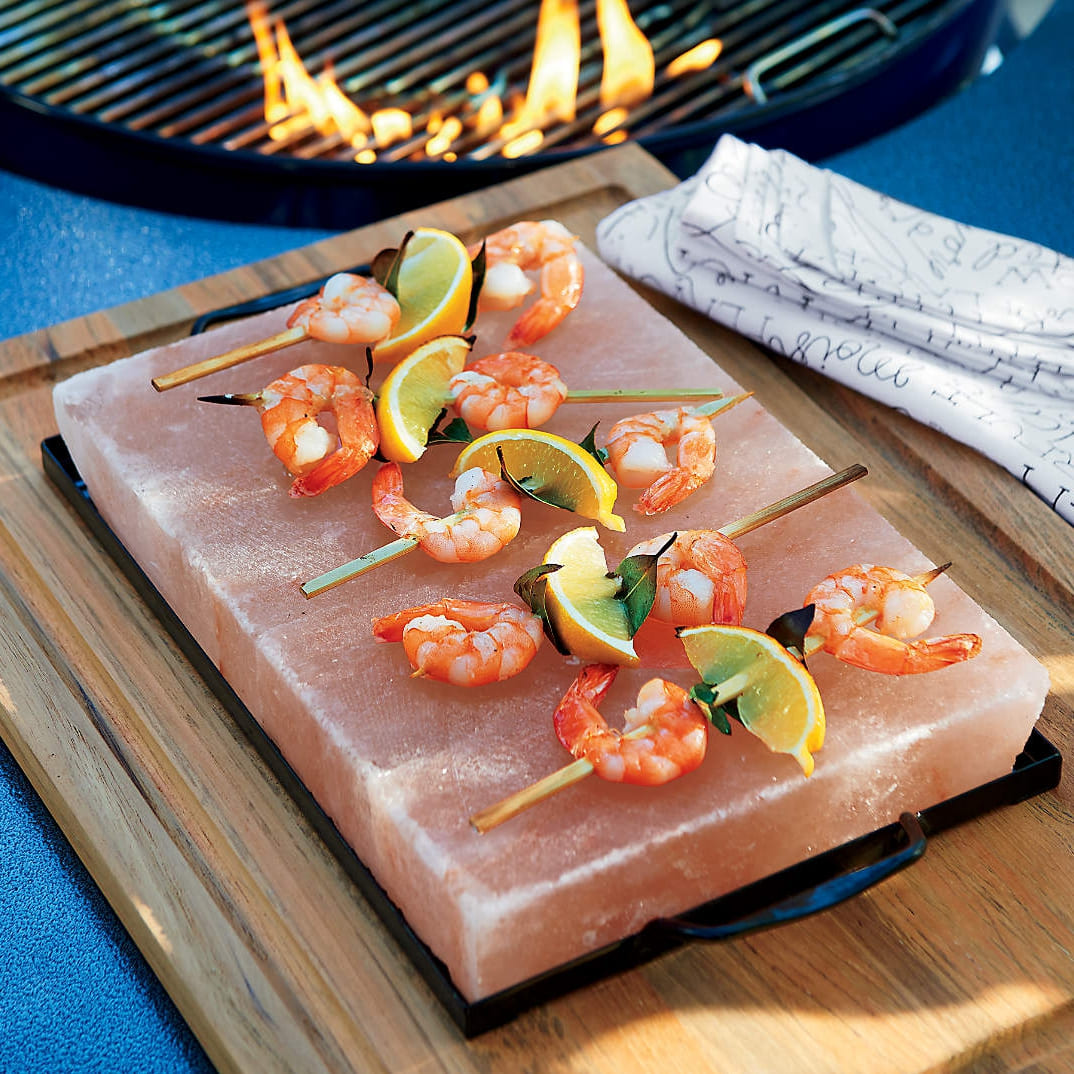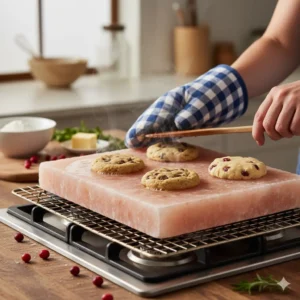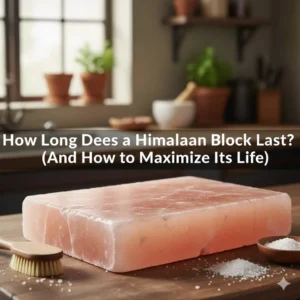Baking on a Himalayan salt block is a cooking technique that uses solid salt slabs to evenly conduct heat and infuse food with a subtle mineral flavor. For bakers, it delivers cookies and scones with crisp, golden bases and a refined balance of sweetness and salinity. This guide explains how to prepare, preheat, and care for your salt block so you can safely achieve consistent, professional-quality results.

Prerequisites: Tools & Materials for Effective Salt Block Baking
Before baking with a Himalayan salt block, ensure your tools are ready and suited for controlled heat transitions. The block must be properly sized and tempered to withstand temperature changes, and your baking setup should prioritize stability and safety. With the correct materials, you can achieve consistent batches of cookies, scones, and other baked goods featuring a refined sweet-salty balance.
- Himalayan salt block, 1.5 to 2 inches thick, for optimal heat retention and even baking.
- Oven or stovetop for gradual preheating.
- Parchment paper or silicone baking mat to prevent sticking.
- Oven mitts or heat-resistant gloves for safe handling.
- Essential baking ingredients for recipes such as cookies or scones.
Assembling these essentials allows you to bake with precision, protect the block’s structure, and ensure each recipe benefits from its natural mineral seasoning.
Step 1: Preheat and Temper Your Himalayan Salt Block Safely
Gradual Heating on the Stovetop or in the Oven
Before baking cookies, scones, or any recipe on a Himalayan salt block, preparing it correctly is essential. The objective is to raise the temperature gradually so the block expands evenly without cracking. Whether heating on a stovetop or in an oven, steady temperature progression prevents thermal shock and preserves the salt slab’s integrity.
Begin at a low temperature, increasing the heat incrementally over thirty to forty-five minutes until the block reaches approximately 400°F (200°C). This gradual rise ensures even heat distribution, which is critical for achieving the crisp, golden base characteristic of salt block baking. Sudden temperature changes can cause fractures that compromise the surface and shorten the block’s lifespan.
Set the salt block on an oven-safe tray or metal rack to maintain airflow beneath it and simplify handling once heated. When properly tempered, the block holds consistent heat for baking cookies or scones, producing a golden, delicately salted finish that surpasses the results of a standard baking stone.
Step 2: Prepare and Bake Cookies and Scones on the Salt Block

Positioning Dough and Using Liners
Before baking cookies or scones, gradually preheat the Himalayan salt block in the oven until it reaches the target temperature specified in your recipe. Place a sheet of parchment paper or a silicone mat on the heated surface to prevent sticking and simplify cleanup. Arrange each portion of dough with enough spacing to allow even heat circulation. Because salt blocks store and radiate heat intensely, monitor baking time closely—cookies or scones may bake slightly faster than on a conventional stone or tray.
Flavor Development and Texture
Baking on a salt block introduces a gentle, layered salinity that complements both sweet and savory doughs. Each cookie and scone emerges with a crisp, golden-brown base and a tender interior. The block’s mineral notes subtly enhance flavors like caramel, chocolate, or herbs without overpowering them. When adapting a favorite recipe, reduce the added salt slightly to maintain balance and let the block’s natural seasoning provide the final, refined touch.
Premium Himalayan Salt Blocks for Culinary & Hospitality
Offer your business authentic, high-performance Himalayan salt blocks sourced from Pakistan’s Khewra Salt Mine. Ideal for baking, grilling, serving, or chilling, our FDA- and EU-approved products come with custom sizing and global delivery options to enhance your menu and brand presentation.

Managing Salt Levels and Recipe Adjustments
When baking on a Himalayan salt block, the surface naturally seasons your dough. Reducing or omitting added salt in cookies or scones helps maintain flavor balance and prevents excessive salinity. Because the block’s heat and mineral composition subtly enhance sweetness, a restrained approach to additional salt produces the most harmonious results.
Test small batches before scaling up to understand how much natural salt the dough absorbs. Evaluate taste and texture after each run, noting that factors such as moisture content, dough thickness, and baking duration all influence how deeply the salt infuses. This careful adjustment process ensures consistent, well-balanced flavor across different baked goods.

Maintaining Your Himalayan Salt Block After Baking
Proper maintenance ensures your Himalayan salt block remains durable and ready for repeated baking sessions with cookies, scones, or other pastries. Although salt is naturally nonporous when handled correctly, giving it time to cool fully before cleaning is essential to preserve its structure.
Avoid detergent or soaking, which can dissolve and weaken the block. Instead, use a slightly damp cloth or soft brush to clear away crumbs and baked-on residue. Gentle pressure is sufficient to remove debris without scratching the surface.
After cleaning, allow the block to dry completely for at least 24 hours in a warm, dry location. This prevents trapped moisture from causing cracks during subsequent heating. With consistent care, your salt block will continue delivering even heat and a delicate savory accent for years of reliable baking.
Additional Culinary Uses for Himalayan Salt Blocks
Beyond baking cookies and scones, a Himalayan salt block can be used for diverse cooking and presentation methods. Its dense, heat-retentive structure distributes warmth evenly, allowing precise searing while imparting a gentle, natural salinity that elevates flavor depth.
Use a preheated block to grill meats, seafood, or vegetables for a balanced seasoning effect without added salt. Many chefs appreciate the dimension it lends to dishes such as seared tuna, shrimp skewers, or sliced zucchini.
When chilled, the same block serves as an eye-catching platter that keeps cheeses, desserts, or appetizers cool. Smaller salt plates can also be used for cocktails or cold beverages, enhancing both presentation and sensory appeal with a refined touch of texture.
Frequently Asked Questions About Baking on Himalayan Salt Blocks
Will my cookies taste too salty when baked on a Himalayan salt block?
Not if the block is properly preheated. It releases only a minimal amount of salt, adding a light savory accent rather than an overpowering flavor. The steady heat helps caramelize the bottoms, yielding a golden, crisp texture with balanced sweetness.
Do I need to adjust the salt in my baking recipes?
Most recipes require only minor adjustments. For delicate doughs such as shortbread or vanilla scones, reduce the added salt slightly to maintain balance. Rich batters like chocolate chip cookies generally retain their intended proportions without issue.
Should I use parchment paper or place the dough directly on the salt block?
Parchment paper prevents sticking and simplifies handling. It also minimizes moisture buildup on the block’s surface. Experienced bakers sometimes bake directly on the salt for firmer doughs, but beginners achieve more reliable results with a lined surface.
What is the correct preheating temperature for baking on a salt block?
Gradually heat the block until it reaches approximately 400°F (200°C). Slow, incremental heating prevents cracking—start at low heat and increase every 10–15 minutes. Once evenly hot, the block provides stable, consistent heat for cookies, scones, and pastries.
Can I bake bread on a Himalayan salt block?
Yes, smaller loaves or rolls work best for even baking. The block imparts a gentle salinity to the crust, similar to a ceramic baking stone but with greater flavor complexity. Allow the block to cool gradually afterward to preserve its integrity.
Final Thoughts
Baking on a Himalayan salt block redefines familiar recipes like cookies and scones. Its natural salinity deepens sweetness and enriches flavor, while its steady heat retention produces a crisp, golden base that few other surfaces can match.
With gradual preheating, thoughtful recipe adjustments, and attentive care, a salt block delivers consistent performance over time. It’s both a practical and inventive tool for expanding your baking repertoire and refining flavor balance.
For those who enjoy exploring new textures and taste nuances, try adapting a favorite recipe for the salt block. You may find that a delicate touch of salt reveals subtleties in chocolate, caramel, or buttery pastries that conventional methods overlook.






